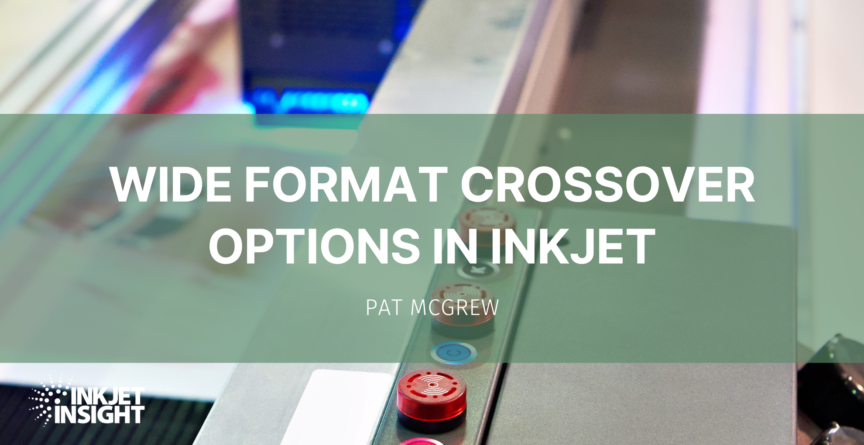In the 2022 Production Inkjet Shopping Guide covering crossover presses, there is an excellent overview of inkjet web presses that are stretching their capability sets in directions that make them an excellent choice for shops catering to diverse customer needs. For example, shops that do direct mail and non-mailed marketing collateral, but also have clients requiring posters, boxes, and labels. In today’s array of inkjet presses there are options that support the needed range of substrates and meet the color requirements. Look at the crossover guide for more information on offerings in that space.
Continuing the theme of crossover inkjet devices, the starting point for this episode is the world of wide format printing. Traditionally, we think of wide-format as the home of popular roll and sheet-fed devices that have inkjet print heads mounted on rails, scanning back and forth across the substrate to build up the image. The technology is available in a variety of price bands supporting a diverse set of substrates. Bringing one of these devices into the shop is relatively easy. Your automated processes may need some additional templates but the lift to integrate a device is typically not too difficult.
However, there are a growing number of interesting options for wide format printing that do not necessarily require investing in a separate roll or sheet fed device because they can handle your print and mail, collateral, books, and your sign and display options, all in one box with single pass printing that is faster! The gaiting factor for your options begins with the width of the single pass device you have and then continues to its substrate capabilities.
Let’s start with the width. If you are running one of the many devices that print 18- to 22-inch-wide rolls of paper, there are opportunities for you! Check on the substrate options for your machine and then check with your local paper merchant. You should be able to find stocks that are appropriate to support A2 and B2 size posters and signs. These can be the perfect offering for store fulfillment kits that need in-store window signs as well as signs that go in frames throughout a store. With a bit of software, you could create an offer that includes some signs and smaller format communication, like hang tags and even brochures for the cashier counter that are ganged together for print, cut apart, and then packaged to head off to the stores.
Your crossover option is to add a cavalcade of new print products to your catalog with minimal additions to your workflow, web-to-print, pricing/estimating, and finishing. Leveraging the versatility of your +/- 20-inch device with sign-appropriate stocks starts with doing some sign printing for yourself! If you have outward-facing windows or use wayfinding signage in your plant, print it on your HSIJ device so you have something to show prospects! It will give you some practice with how the substrates behave, the print speeds to use, and how to mount the signs.
Now let’s say you have one of the high-speed inkjet devices that prints wider than 22 inches. Today you can buy devices that print 30+ and 40+ inches wide, opening the door to large format print! Consider one inkjet printer who found they could print store window signage on their high-speed inkjet device between runs of longer jobs and bring it in at a tenth of the print cost they would see on their wide format devices. That versatility creates crossover opportunities that can change the products offered and even change approaches to pricing. If you are currently printing on traditional wide-format inkjet devices and have a pricing model built for that, moving work to a high-speed single-pass inkjet device can reduce costs resulting in production savings that you may choose to share with clients, or not.
The use case described above for printing store window signs works with these larger presses, too. Think about signs in the windows of banks, retail stores and grocery stores. They often change frequently, so they don’t require long-term lightfastness or UV protection. One owner of high-speed inkjet found that they could print signs duplex, with the image on the verso side printed as a mirror image of the front. The result was that the sign looked as though you could see through it, and at night with store lights behind it, the sign glowed!
Everything described to this point refers to roll-fed devices, but the same opportunities apply for owners of sheet-fed production inkjet devices. Start by looking at your sheet size options, talk to your paper merchants about substrates, and try printing a few internal-use signs. Try some heavier substrates and some mid-weight substrates to see how they look. Try mounting them and see how they work in your shop. Then start showing them to potential clients! It’s ink on a substrate, and you know how to do that!
Remember that high-speed inkjet devices run at different speeds, often offer drying options, and use ink that needs to stick and dry. Talk to your vendor about your options for offering crossover print options to your customers.

